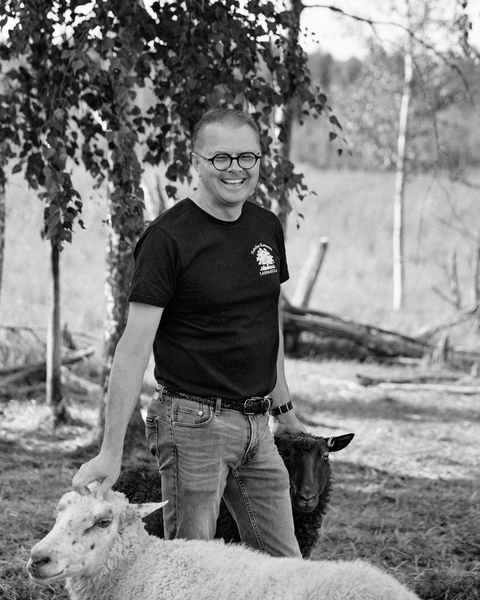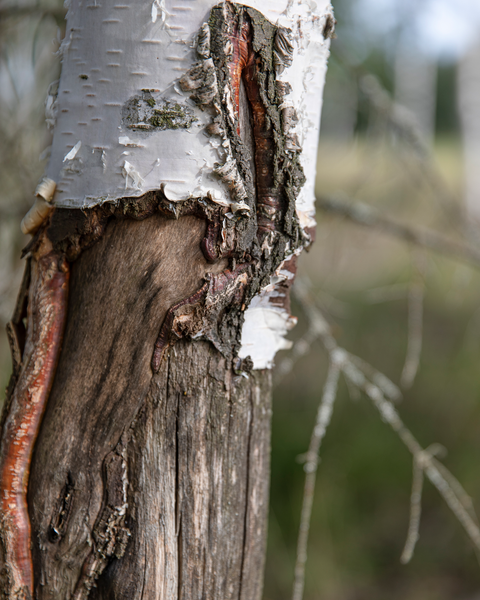Sheep Farming at Tolvila Manor
Learn how sheep farming can help save endangered biotopes.
At Tolvila Manor’s sheep farm, nature receives its fair share of love and care. While grazing in the traditional landscape, the sheep help make sure that endangered insects, plants and birds continue to have a home in the future. Knitters do their part, too.
“Come on ladies, over here,” Jarmo Latvanen calls out.
A tightly packed flock of sheep trots over, their eyes on Jarmo’s bucket of oats. We are at the sheep farm of Tolvila Manor, located on the shore of Lake Vanajavesi in hilly countryside near Tampere, Finland. Jarmo is the owner of the farm – he prefers to call himself a shepherd – and these are some of his flock of 172 sheep.
If you squint in the right way, you can imagine the landscape being the same for centuries. Rough grazing lands, small patches of forest, blocks of stone, a felled tree gnawed bare by the sheep. In one corner of the pasture there is a large boulder that may have once been used as a site for lighting beacons. The area has been inhabited since the Stone Age, and the Tolvila estate itself was established back in 1650.
Nowadays, the sheep at the organic farm are Finnsheep, a breed native to Finland. Their meat is sold in the farm’s own shop and their wool used for knitting trendy hats.
But the animals aren’t the only thing being looked after at Tolvila – the landscape and nature get their due, too. Besides the sheep, these pastures are home to hundreds of other species: plants, insects, birds, fungi, micro-organisms in the soil. Here you can find, for example, larvae of the Agrilux mendax, a rare jewel beetle, which thrive on the rowan trunks damaged by the sheep, along with several endangered or near-threatened moths and butterflies.
They are all part of the same threatened rural habitat, or biotope. And for them to keep thriving, it is essential that Jarmo’s flock continues to graze here.

Cultural Nature
To understand the complex web of interconnections present in a pasture, we must first understand the changes that agriculture has gone through. In just over a hundred years, farming has been revolutionised completely.
In Finland, there used to be only small areas of cultivated land, because preparing the soil by hand was an arduous task. What grain and root vegetables the few fields yielded were used for human sustenance, and the animals had to search for their own food in rocky wastelands, islands, forests and banksides. This tradition went on for hundreds of years, all the way from the Bronze Age to the end of the 19th century. At the same time, the animals shaped the landscape, and these circumstances gave rise to meadows, fields and pastures, each with its own flora and fauna.
As agriculture developed, the animals, too, began to eat cultivated crops, namely hay. Grazing shifted from meadows in the forest to fenced enclosures near cowsheds. Traditional pastures began to overgrow.
“Nowadays these biotopes are threatened in themselves as well as being the habitats of several endangered species,” says Laura Puolamäki, PhD, who works as a landscape expert for the Southern Finland regional centre of ProAgria, an agricultural consulting organisation. She is part of a project that has surveyed the range of species present in nine rural biotopes.
Lately, public discussion about environmental matters has been dominated by climate change – and for good reason – but in addition to that, people have become alert to another great threat: the loss of biodiversity. That is exactly what is at stake with the diminished rural biotopes, even if we tend to connect species loss only with areas of unspoiled nature, such as virgin forests. Rural biotopes have a cultural nature, arising from human activities.
“Nature has adapted to humans living here. We are one with nature. If humans are taken out of the equation, it has consequences for nature,” Jarmo Latvanen says.

Closely Watched Crazing
In Finland, there is now an ongoing effort to restore traditional biotopes so that their total area rises to about 52,000 hectares from the current 25,000–30,000 hectares. Livestock owners whose animals use traditional biotopes for grazing are given agricultural subsidies. The use of the areas is planned and surveyed closely so that there is just the right amount of grazing.
Finnish sheep often use natural pastures for grazing, but all grazing animals have their role in the endeavour. Waterfowl habitats, for example, do best in combination with cows, who feel at home right up to the shoreline, while sheep prefer to keep their hooves dry.
For Laura Puolamäki, the findings of their research project are hopeful. In the nine pastures, they made sightings of endangered insects, plants, fungi and birds, and in places the situation was brighter than expected.
“It means that there are still adequate habitats for these species and we can do something about it.”
Though we are talking about Finland, the same principles apply globally. The risks for pastures and similar areas are related to excessive grazing, which (in Scotland and Iceland for example) has resulted in loss of biodiversity and made the soil more vulnerable to erosion. It is vital that the keeping of animals is based on research to aid the recovery of biodiversity.

A Newfound Appreciation of Wool A
Swallows are whizzing around below the ceiling of Tolvila’s sheep barn. Inside, you can smell the dry hay used as bedding for the sheep.
Twice a year, in the spring and autumn, the sheep are shorn. The wool is cut at the root to keep the fibre as long as possible, ensuring a high-quality yarn. Finnsheep wool is fine, soft and lustrous, and nowadays, people appreciate it. That hasn’t always been the case, however.
On most Finnish farms, the wool is a by-product of meat production. It has sometimes even been burned because there has been no demand for it, or no one has been willing to pay a reasonable price for it. The sheep at Tolvila produce around 1,000 kilograms of wool per year, bringing in €6,000, perhaps – formerly, it didn’t always yield any money at all. Jarmo feels that for an animal’s life to not be wasted, one should make good use of it all: the bones, the organs, the skin and the wool. That is why knitters are important for sheep farming.
For the past ten years, there has been a determined reappraisal of Finnsheep wool, and the knitting craze of recent years has upped demand for it. An important player has been the Myssyfarmi company, who make knitted products using Finnsheep wool, and they are the main buyer for wool from Tolvila.
“They are now selling Myssyfarmi hats at the Galeries Lafayette in Paris. It’s been a rapid change.”

Ethical Meat-Eating
It is both Laura and Jarmo’s wish that people refrain from lumping together all types of animal husbandry. Imported, soy-fed beef from intensive farming and locally produced, naturally grazed mutton from an organic sheep farm are two very different things. Besides enhancing biodiversity, grazing also has a smaller environmental impact as the animals aren’t fed on separately produced fodder. The meat is also often sold to local consumers.
“Because the amount of information is lacking, the discussion is skewed and all meat-eating and perhaps even the use of natural wool is seen as bad. But if there is no market for meat and wool, there is no animal husbandry. That would mean the end of grazing, which in turn would lead to the loss of habitats that are crucial for the survival of endangered species,” Laura sums up.
She notes that this doesn’t mean you should eat meat every day. But if you eat meat once a week, perhaps, you can select your products more carefully and pay a bit more for ethically sourced meat.
“Unfortunately, it isn’t always easy as a consumer to choose the right product. A skein of wool should also clearly state what it means if you select this yarn.”
Jarmo Latvanen has another profession as a priest, and he finds the ethics of sheep farming important. He thinks that in order to work, an industry has to be viable for everyone and everything involved in it: companies, producers, animals, nature. Values should come before financial gain, and there should be no exploitation.
In a traditional biotope, the people and animals are part of the same chain, but it is mankind’s role in the chain that is the crucial one. All traditional environments are born because of human activity, and they survive only if people make them survive. At one end of the chain, there is a sheep rubbing itself against a rowan, with a larva crawling on the tree trunk. At the other end, there is a fashionable Parisian woman, putting on a Myssyfarmi hat knitted in Pöytyä, Finland.
Text: Maija Kangasluoma
Photos: Sini Kramer
Translation: Sami Pulliainen
This feature was first published in Laine issue 15.

